Top Circular Saws Review: Features and Insights
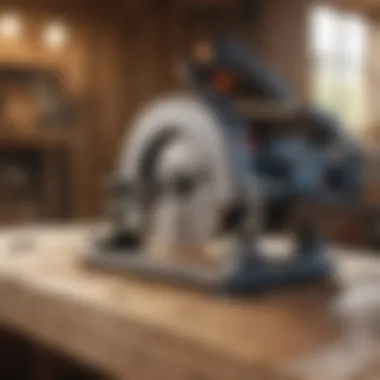
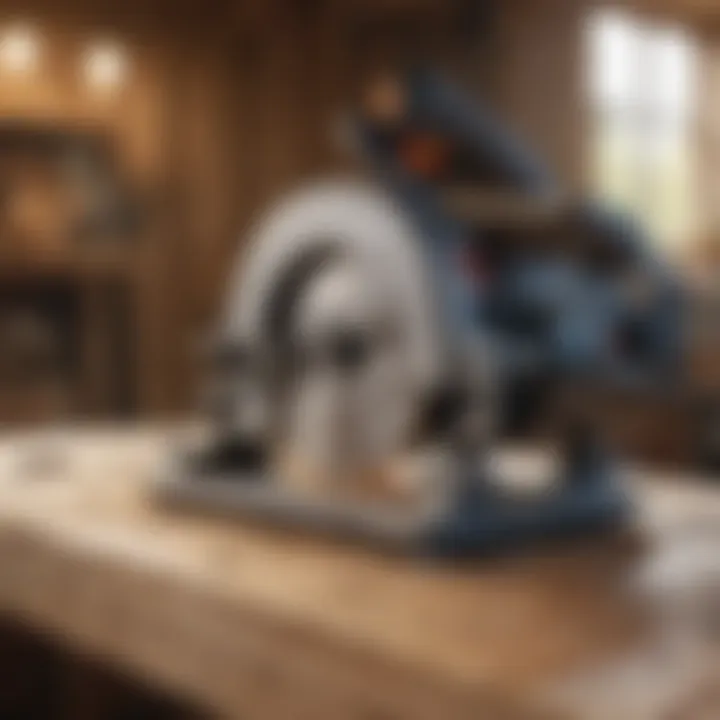
Intro
In the realm of home improvement, the circular saw stands as a pivotal tool for both seasoned contractors and enthusiastic DIYers. These versatile devices allow for precise cuts across various materials, from plywood to thick lumber. Understanding their features and performance can significantly enhance one’s woodworking projects, whether it’s crafting custom furniture or tackling basic repairs around the house.
The Importance of Circular Saws
Circular saws do more than just cut; they empower individuals to take on ambitious projects with confidence. With advancements in technology, modern models offer safety features, ergonomic designs, and enhanced power, making them suitable for users with different skill levels. Knowing how to evaluate these saws enables homeowners to choose a product that not only meets their needs but also provides longevity and efficiency.
Common Challenges and Solutions
Although circular saws are powerful, several common challenges can impede their effective use. Many users, particularly those new to the craft, struggle with handling and safety issues. Here’s a closer look at some typical obstacles:
Common Issues Faced by Homeowners
- Inadequate Safety Knowledge: Many novice users may not fully grasp safety protocols.
- Poor Cutting Accuracy: Misalignment or incorrect blade selection can lead to uneven cuts.
- Tool Maintenance Oversights: Neglecting regular upkeep can impair performance over time.
Solutions and Tips to Overcome These Challenges
- Educate on Safety Protocols: Always read the user manual and watch instructional videos on safe operation.
- Test Blade Options: Try different blades for specific materials; selecting the right blade makes all the difference in achieving clean cuts.
- Implement Regular Maintenance: Clean your saw after each use and inspect the blade for dullness or damage.
"A well-maintained circular saw is a happy saw—its performance can greatly affect your projects!"
Product Recommendations
When it comes to selecting a circular saw, several standout options in the market cater to various needs and budgets. Here are some noteworthy products:
Detailed Analysis of Top Products
- DeWalt DWE575SB
- Makita XSH06Z
- Benefits: Lightweight design, ergonomic handle, and integrated blade guard for added safety.
- Features: 7-1/4 inch blade, an anti-kickback feature, and a powerful motor that delivers impressive cutting power.
- Benefits: Cordless freedom with high battery efficiency, allowing for maximum portability.
- Features: Brushless motor for longer run time and smoother operation.
These tools have earned accolades from both professionals and home enthusiasts, ensuring reliability and top-tier performance for a wide range of projects.
Step-by-Step Guides
To ensure you get the most from your circular saw, here’s a detailed guide on enhancing your cutting experience:
Practical Steps to Implement Improvements
- Setting Up Your Workspace
- Understanding Blade Types
- Operation Techniques
- Choose a stable and well-lit area to prevent accidents.
- Use clamps to secure materials firmly, minimizing movement during cutting.
- Different blades serve specific purposes; familiarizing yourself with these helps in selecting the right one for the job.
- Always maintain a firm grip on the saw with both hands for stability.
- Slowly guide the saw along the marked line and let the tool do the work—force can lead to mishaps.
By following these detailed instructions, you'll not only improve your cutting skills, but also enhance your overall safety and efficiency during projects.
Prelims to Circular Saws
In the realm of woodworking and construction, the circular saw stands as an indispensable tool. For housewives and homeowners aiming to undertake home improvement tasks, understanding this powerful device can be a game changer. Circular saws not only increase the efficiency and precision of cuts but also elevate the safety and overall experience of working with wood.
Definition and Purpose
A circular saw is a power-saw that uses a toothed or abrasive disc to cut through various materials. It spins around an arbor that holds the blade in place, making it capable of cutting through wood, metal, plastic, and more. The primary purpose of this tool is to provide clean, accurate cuts quickly. The versatility it offers has made it a staple in both professional and amateur tool kits.
Using a circular saw can simplify tasks like making straight cuts for framing, ripping boards, or even complex joinery when paired with the right guide. Homeowners often find it a remarkable ally in DIY projects, saving them the effort of hiring a professional while giving them the sense of accomplishment from crafting their own furniture or home fixtures.
Historical Development
The history of the circular saw is quite fascinating and reflects the evolution of carpentry tools over the years. The first known circular saw was invented by Tabitha Babbitt in 1813, a Shaker woman who sought to improve the efficiency of her community. She designed a saw that integrated a rotating blade, dramatically reducing the physical effort needed to cut through lumber.
From Babbitt's original design, circular saw technology advanced considerably. In the late 19th century, the invention of electric motors transformed the circular saw into a power tool, enhancing its speed and cutting precision. Today's models are lightweight and equipped with advanced features like laser guides and ergonomic designs, making them user-friendly for everyone, regardless of experience.
Having a grasp on both the definition and historical context of circular saws allows consumers to appreciate how far technology has come, influencing their choice when picking the best circular saw for their needs.
"Understanding the origins and purpose of a tool is equally important as knowing how to use it effectively."
When the modern homeowner looks at a circular saw on a shelf, it is not just a product; it is the culmination of years of innovation representing craftsmanship and utility. This integrated knowledge empowers individuals to make thoughtful decisions, ensuring they select a saw that meets their specific requirements.
Key Features of Circular Saws
When selecting a circular saw, understanding the key features is crucial. Circular saws are not merely tools; they are extensions of your craftsmanship. Knowing what to look for can significantly enhance your woodworking projects, whether you're a seasoned carpenter or a DIY enthusiast at home.
Blade Types and Sizes
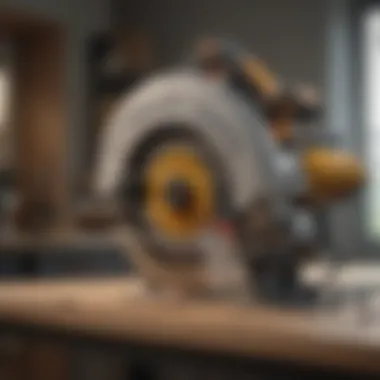
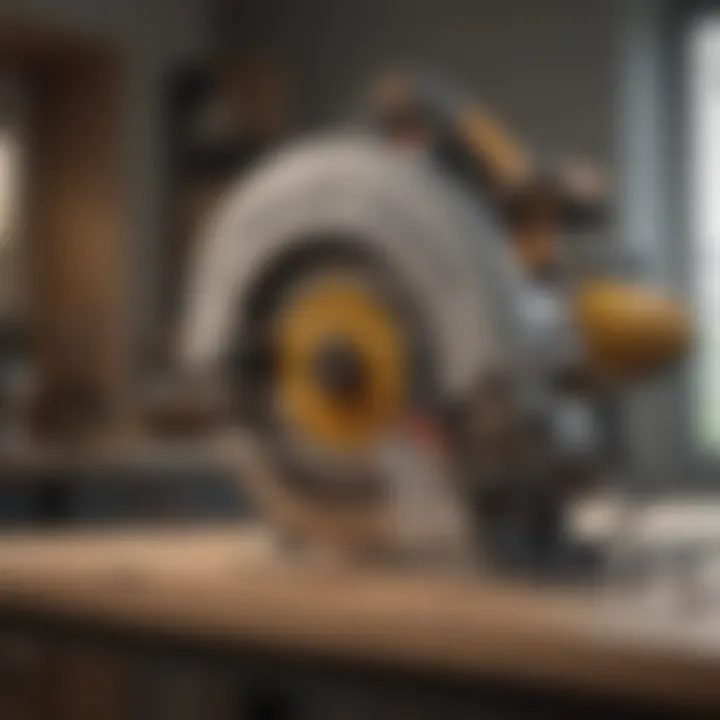
Blade type and size are among the most critical aspects to consider. Different tasks call for different blades, much like how a chef chooses their knife based on the dish they plan to prepare. For instance, standard blades range from 7-1/4 inch to 10 inch, but specialized blades exist for milling, masonry, and metalwork.
- General Purpose Blades: Perfect for most cuts, these blades have a balanced combination of teeth count and material.
- Thin Kerf Blades: These are designed to minimize material loss during cutting, making them favorable for projects where precision counts.
- Specialized Blades: If your project involves cutting through specialized materials like laminate or thick metal, look into the respective blade designed for those tasks.
Selecting the right blade not only ensures cleaner cuts but also alleviates strain on the motor, enhancing overall performance. A poor choice in blade can lead to chipping, binding, or worse, overheating the motor which may damage the saw.
Power Ratings and Motor Types
The power of a circular saw is typically indicated by its amperage or voltage in cordless models. A higher power rating translates to the ability to handle tougher materials with ease. Think about it like car engines; a higher horsepower can pull heavier loads more efficiently. Generally, you want a motor that provides at least 15 amps for heavy-duty tasks.
Different motor types also come into play:
- Brush Motors: These are often found in more affordable saw models. They tend to be reliable but may not last as long under heavy use.
- Brushless Motors: These are becoming the norm in modern saws, offering better efficiency and longevity. Less friction means they generally generate less heat, preserving the integrity of your saw over time.
Opting for a saw with the right power and motor type can dramatically affect your efficiency and success rate in various cutting projects.
Weight and Portability
For many home DIYers and even professionals, the weight of a circular saw can dictate how comfortably and effectively you can handle it. A heavy saw might deliver power, but it can also cause fatigue during extended use. Conversely, a lightweight saw offers ease of maneuverability but may sacrifice durability and performance.
When considering weight:
- Corded Models: These are usually heavier due to the larger motors but don’t worry about battery life.
- Cordless Models: While these are lighter and more portable, battery size and technology influence how much power you can get.
Ensuring that you have a portable circular saw that strikes the right balance between weight and performance will streamline a project from beginning to end. It is worth investing time in finding a saw that feels good in your hands, as this can lead to better results in your cutting tasks.
"A tool that feels right will turn a cumbersome project into a joy of creation."
Assessing Performance
When it comes to circular saws, assessing performance is non-negotiable. This aspect reflects how well the saw can handle various tasks, from simple cutting jobs to more complex projects, determining not just the efficiency, but also the quality of the results. Manufacturers pour a great deal of technology into their tools, making it essential for consumers to look beyond just the surface features and examine the nuts and bolts of what makes a circular saw tick.
Cutting Speed and Precision
Cutting speed plays a crucial role in getting the job done quickly and accurately. Different materials require different speeds; for instance, cutting through softwood, hardwood, or even metal necessitate varying blade speeds to achieve clean and precise cuts. The importance of choosing the right speed cannot be stated lightly — too slow, and you risk burn marks and a rough finish; too fast, and you might damage the material or even ruin your blade.
You might find circular saws with adjustable speed settings beneficial here. These settings allow the user to tailor the saw’s performance to the material being worked on. For example:
- Softwoods can generally be cut at higher speeds.
- Hardwoods may benefit from a slightly slower speed to reduce the risk of splintering.
- Metal and other dense materials require specific blades and usually slower speeds to manage the heat build-up effectively.
Precision, on the other hand, is all about clean cuts and minimizing the need for extensive post-processing. Ensure the saw has quality features like laser guide systems or LED lights to enhance visibility and accuracy, particularly when working with intricate designs or in tight spaces.
Durability and Build Quality
Durability is another pillar in the performance evaluation of circular saws. A tool built from high-quality materials can withstand the rigors of frequent use. Look for saws with solid metal housings, as opposed to plastic ones, which can warp and break under pressure. The motor also plays a sizable role in build quality. A brushless motor not only increases lifespan but consistently delivers performance without the wear and tear that traditional motors may face over time.
Brands like DeWalt and Makita invest heavily in research and development to ensure their tools are both strong and effective. Consider the warranty too; a longer warranty period can be indicative of a manufacturer’s confidence in their product's durability.
Vibration and Noise Levels
Lastly, let’s tackle the often-overlooked factors of vibration and noise levels. Excessive vibration can lead to operator fatigue, slowing down work rates and compromising the quality of cuts. Some circular saws come equipped with anti-vibration technology, which can drastically reduce the strain on your hands and arms when cutting for extended periods.
Furthermore, noise levels can be a point of contention in residential settings. If you’re working on home improvement projects, a quieter circular saw can keep the peace between you and your neighbors. Look for models that come with sound dampening features — they make a world of difference to the user experience.
Key Takeaway: Overall, assessing the performance of a circular saw involves looking at cutting speed, precision, durability, vibration levels, and noise. Each of these elements contributes to whether a saw will meet your specific needs and help produce clean, efficient results every time you make a cut.
Top Circular Saw Brands
When choosing a circular saw, paying attention to the brands behind the tools is paramount. The best circular saws are often produced by companies that have carved their niche in the industry with innovation, quality, and user satisfaction at the forefront. Brands like Bosch, DeWalt, Makita, and Milwaukee each bring unique advantages to the table. This section will explore these top manufacturers, shedding light on their specific offerings. Understanding the strengths and weaknesses of these brands can serve as your compass, guiding you to make an informed choice based on your needs and preferences.
Bosch: Innovation and Reliability
Bosch stands tall in the world of power tools, particularly for circular saws. This German brand is known for its commitment to precision and durability. Their circular saws often come with advanced features that enhance the cutting experience. For instance, the Bosch GKS 12V-26 showcases a compact design and a lightweight structure, enabling users to navigate tight spaces without much hassle.
In addition to its ergonomic design, Bosch continually invests in technological advancements. The integration of the Constant Response Electronics ensures a steady performance, allowing the user to maintain speed under load. This reliability can be a game changer for DIY enthusiasts and professionals alike, enhancing efficiency on the worksite.
DeWalt: Performance-Driven Tools
When it comes to performance-driven circular saws, DeWalt is synonymous with power and durability. Recognized for their robust constructions, DeWalt circular saws are engineered for various cutting applications, ranging from framing to finish work. The DeWalt DCS570B is a vivid example of their commitment to excellence – it offers a high torque motor for optimum performance.
Moreover, what sets DeWalt apart is their battery technology. Their FlexVolt system allows users to switch between 20V and 60V tools, broadening the scope of capabilities available at your fingertips. This versatility is particularly beneficial for homeowners who might need different tools for renovations or maintenance projects.
Makita: A Legacy of Excellence
With decades in the game, Makita has built a legacy that highlights dependability and performance. Their circular saws, such as the Makita XSH03Z, are often celebrated for their smooth cutting capabilities and impressive battery life. The design caters to high efficiency and user comfort, thereby reducing fatigue during prolonged cutting sessions.
Furthermore, Makita prides itself on safety features. Many models are equipped with electric brakes, preventing accidental blade engagement. This attention to safety is crucial, especially for newer users who might not have extensive experience with power tools. Having a tool that incorporates safety measures offers peace of mind, enabling effective work without compromising user wellbeing.
Milwaukee: Cutting-Edge Technology
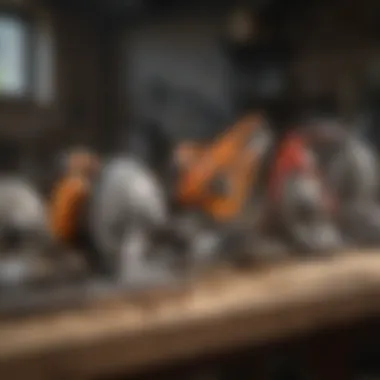
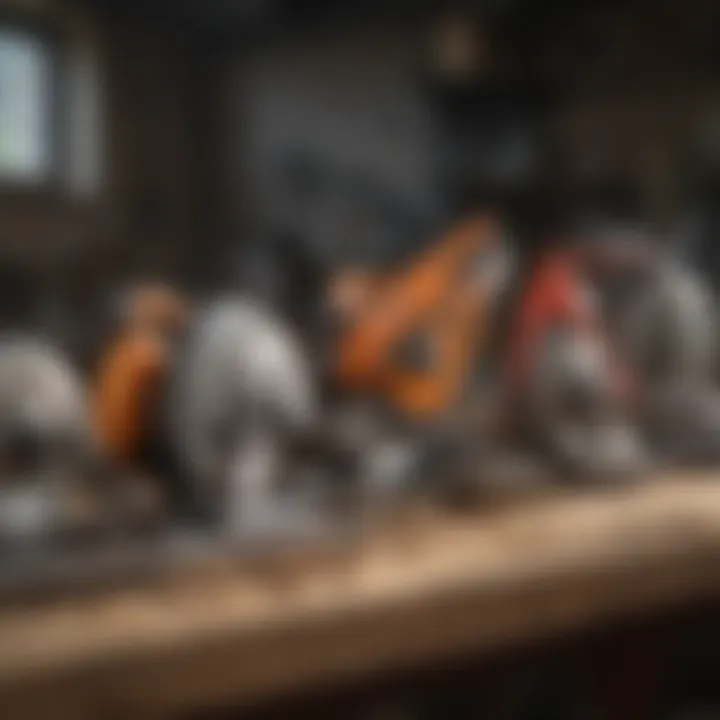
Milwaukee stands out in the industry's competitive landscape, primarily due to their relentless pursuit of innovation. Known for fostering advanced technology, Milwaukee’s circular saws, like the M18 Fuel series, integrate Powerstate Brushless Motors that provide longer run-time and increased durability.
This brand focuses not only on efficiency but also user-friendly features. Their saws typically come with built-in lights, enhancing visibility in dimly lit areas. Moreover, the sturdy rafter hook allows for easy storage, making Milwaukee tools as convenient as they are powerful.
In summary, each of these brands – Bosch, DeWalt, Makita, and Milwaukee – offers specific traits that cater to distinct user needs. Knowing the strengths of each brand helps narrow down choices, ensuring that you pick a circular saw that fits your cutting tasks and is easy on the wallet.
Comparative Analysis of Leading Models
The comparative analysis of leading models in the circular saw market is a crucial segment of this guide. It not only sheds light on various saws but also helps potential users make well-informed decisions. With a plethora of options available, understanding differences in features, performance metrics, and suitability for specific tasks is paramount. This analysis allows users to know what they are getting into before making a purchase, ensuring that they are choosing the right tool for their needs.
In this section, we will dissect three pivotal categories based on the user profile and usage: Entry-Level Options, Professional-Grade Models, and Heavy-Duty Solutions. Each of these categories caters to a distinct user base, highlighting the factors that set them apart as well as the advantages they offer.
Entry-Level Options
Entry-level circular saws are designed primarily for homeowners or DIY enthusiasts who are just starting out in the world of woodworking or renovations. These saws strike a balance between affordability and functionality. Here’s what to expect from entry-level models:
- Price Point: Most entry-level options are budget-friendly, making them ideal for novice users.
- Weight: Generally lighter, they are easier to maneuver, which is beneficial for beginners.
- Power: While they may not have the highest horsepower, they still deliver decent cutting performance for common household tasks, such as trimming boards or cutting plywood.
For instance, consider the Ryobi P508, which offers an impressive blend of price and performance, making it a popular choice for home projects.
"Whether it’s for crafting some storage shelves or tackling minor renovations, an entry-level saw can be your best friend."
Homeowners should keep in mind that while these saws are easy on the wallet and user-friendly, they might lack some advanced features found in higher-end models. It's a foundational tool for those looking to explore more complicated home projects down the line.
Professional-Grade Models
For those who take on more ambitious woodworking projects or require high-performance tools, professional-grade circular saws are the way to go. Tailored for contractors or serious hobbyists, these saws bring robustness and reliability:
- Enhanced Power: Typically, these models boast higher power ratings, allowing them to cut through tougher materials with ease.
- Advanced Features: You'll find features like laser guides for precision, variable speed settings for diverse applications, and durable construction meant to withstand frequent use.
- Ergonomics: Comfort is key for professionals who may be using these tools for extended periods. Features like anti-slip grips and balanced design come into play.
A notable option in this category is the DeWalt DWS779, known for its unwavering performance and build quality, making it perfect for serious remodelers and construction workers.
Heavy-Duty Solutions
When the job is on a larger scale, or you're working with very thick materials, heavy-duty circular saws come into play. These tools are engineered to meet the demands of industrial or large-scale commercial applications:
- Maximized Power: Heavy-duty saws often exceed power ratings of their lighter counterparts, allowing them to tackle the toughest cuts without breaking a sweat.
- Heavy Construction: Built with robust materials, these saws are designed for durability, ensuring they can handle rigorous daily tasks.
- Safety Features: These models often include advanced safety protocols, which is vital given the potential hazards associated with heavy power tools.
An example is the Makita 5007MG, which delivers exceptional performance in tough conditions thanks to its powerful motor and large cutting capacity.
When choosig a heavy-duty solution, it’s wise to factor in the specific types of projects you'll be undertaking, as these saws can come with a heftier price tag.
In summary, the comparative analysis of circular saws provides an in-depth look at different models catering to a variety of user needs. Understanding the distinctions across entry-level, professional-grade, and heavy-duty options allows users to make educated choices, matching their selected saw to their unique requirements.
Considerations when Choosing a Circular Saw
When diving into the world of circular saws, it can be pretty overwhelming considering the number of options available. However, understanding the considerations when choosing a circular saw is crucial. This part of the article brings together all the essential factors that can guide both seasoned pros and novices alike through the selection process.
Choosing the right circular saw isn't just about grabbing the shiniest model off the shelf. It's about aligning the saw with your specific needs. Making a poor choice could lead to frustration with the tool and even hinder your project. Hence, considering elements like intended use, budget, and after-purchase support becomes essential.
Intended Use and User Experience
Think about what you plan to use your saw for. If you just need it for occasional DIY projects around the house, then a deluxe model might be overkill. On the other hand, professionals undertaking heavy-duty work will need something more robust.
- Types of Projects: Will you be cutting plywood, framing lumber, or perhaps laminate? Each task has its own set of requirements.
- Skill Level: A beginner might appreciate features like lighter weights or safety features, whereas a professional might prefer enhanced speed and power.
User experience is paramount. The way a saw feels in your hands can impact not just how effectively you work but also the quality of your results. A well-balanced saw reduces fatigue and increases confidence when cutting.
Budget Constraints
Next up is the wallet. Setting a budget might feel like putting on shackles in the buying process, but it’s prudent. You may find quality options at different price points, but sticking to your budget ensures you won’t have buyer’s remorse later on. Additionally, try to consider not just the price of the saw itself but the long-term costs as well:
- Accessories: Blades, carrying cases, and additional batteries (if it’s cordless) can add up.
- Lifecycle Costs: Consider the durability of the model versus its upfront cost. Sometimes, a higher initial investment pays off over time.
Warranty and Customer Support
Finally, let’s chat about warranties and customer service. If you invest time and cash into a saw, having support should anything go wrong is non-negotiable. Warranties can be a major selling point. Check these aspects:
- Length of Warranty: A longer warranty often reflects a manufacturer’s confidence in their product.
- Customer Support: Read reviews or share threads online, like on reddit.com, to gauge user experiences with warranty claims and support.
"A good warranty is like a safety net; it gives you peace of mind for that leap of faith into buying a new tool."
Thus, aligning your needs with smart budgeting and solid after-sales support can help you identify the circular saw that will serve you best over the years.
Safety Protocols
In the world of circular saw usage, safety protocols serve as the cornerstone for not just effective operation but also maintaining personal well-being. Proper safety practices can turn a seemingly simple task into a secure experience. The importance of adhering to safety measures can't be overstated, especially given the inherent dangers associated with power tools. Understanding these protocols not only aids in efficient use but also instills confidence in users, whether they’re seasoned pros or weekend warriors.
Personal Protective Equipment


When operating a circular saw, wearing the appropriate personal protective equipment (PPE) is crucial. This gear acts as your first line of defense against accidents and injuries.
- Safety Glasses: Protect your eyes from flying debris. Bits of wood or other materials can easily become projectiles.
- Hearing Protection: Circular saws can generate noise levels that exceed safe limits. Earplugs or earmuffs can help prevent potential hearing damage.
- Gloves: While they maintain grip and protect your hands, it’s important to choose gloves designed for power tool work; they should not be too bulky.
- Dust Mask: When cutting materials like MDF or plywood, dust can be hazardous. A dust mask is essential for protecting your lungs.
- Steel-Toed Boots: If you're working on floors that may have falling objects, a pair of sturdy boots can prevent serious injuries to your feet.
Implementing these safety measures not only safeguards your health during use but also enhances your focus on the task at hand—allowing you to be more productive.
Operational Guidelines
Operational guidelines are the nuts and bolts of safer circular saw usage. Following these guidelines mitigates risks and ensures that you can achieve quality results without compromising safety.
- Read the Manual: Before ever powering up your circular saw, take a good look at the manual. Familiarize yourself with the layout, functions, and safety features of the tool.
- Inspection Before Use: Perform a quick inspection of the saw to ensure that everything is in working order. Check the blade for damage and ensure that all screws and fasteners are tight.
- Secure the Workpiece: Always use clamps or vises to secure the material you’re cutting. This prevents the material from moving unexpectedly during the cutting process.
- Cut Away from Your Body: This might seem intuitive, but in the moment, it can be easy to forget. Always position your body to avoid the line of the blade.
- Keep Others at a Safe Distance: Make sure that any onlookers or helpers stand back to avoid injury, as flying debris can pose a risk.
"A moment of hesitation can lead to a lifetime of regret. Always be prepared and safe!"
By adhering to these operational guidelines, you’ll not only foster a safer work environment but also improve the quality of your cuts and the longevity of your equipment.
Adhering to safety protocols is key in ensuring that you can enjoy your projects without mishaps. Whether it's a simple home renovation or an ambitious DIY task, keeping safety at the forefront transforms the experience from merely productive to genuinely enjoyable.
Maintenance Practices
Maintaining a circular saw is not just about keeping it clean; it’s about ensuring that the tool operates safely and effectively over time. A well-maintained saw not only enhances performance but also extends its lifespan. For homeowners, understanding maintenance practices is essential to avoid costly repairs or replacements. Let’s delve into the specifics of how to care for your circular saw.
Regular Cleaning and Inspections
Regular cleaning isn’t just a good habit; it’s crucial for the proper functioning of your circular saw. Blade dust and debris can accumulate in the casing and around the motor, potentially leading to overheating or malfunction. Just giving it a once-over at the end of a project can save a lot of headaches down the road.
- Why Cleaning Matters: Dirt and grime can be a double-edged sword. Not only can they affect performance, but they can also pose safety risks. A clean saw allows for smooth cutting, while a dirty blade can snag and lead to kickback.
- What to Inspect: Check the power cord for any signs of wear. Damaged cords can lead to electric shocks. Additionally, inspect the base plate for any bends. A warped base can cause inaccurate cuts, which is a big no-no for precision work.
Here are some simple steps for cleaning:
- Unplug the saw. Safety first!
- Use a brush to remove dust from the blade and motor vents.
- Wipe down all accessible surfaces with a damp cloth.
- Inspect and clean the base plate, ensuring it's free from scratches.
“Routine checks are the best way to avoid major faults later on.”
Blade Replacement and Upkeep
The blade is the heart of your circular saw, and how you care for it can make or break your woodworking projects. Knowing when and how to replace your blade ensures you achieve accurate and efficient cuts.
- Signs of a Worn Blade: If you notice that your cuts are less precise or if the saw struggles to cut through materials it previously handled with ease, it’s time to consider a blade replacement. Other indicators include visible damage, such as chips or cracks, and excessive noise during operation.
- Choosing the Right Blade: When you find yourself in need of a new blade, knowing the correct type is half the battle. Whether it’s a fine-toothed blade for intricate work or a coarse blade for thicker materials, the right fit makes a world of difference.
To maintain the blade:
- Clean it after each use; this prevents resin buildup and keeps it sharp.
- Store it properly, keeping it in a protective case to avoid accidental damage.
- Regularly check for alignment to ensure straight cuts.
In the long run, investing a bit of time in maintaining your circular saw not only saves you money but also enhances the quality of your work. So whether you’re cutting plywood for home improvements or crafting furniture, a well-maintained saw will give you the best results.
Emerging Trends in Circular Saws
In the ever-evolving landscape of power tools, circular saws are not left behind. The emergence of new trends is reshaping user experience and performance standards. Understanding these trends is vital for anyone looking to invest in a circular saw. It gives insight into whether a tool will meet future demands and offers enhanced usability.
Battery Technology Advancements
Battery technology has revolutionized how we view circular saws. The shift from corded tools to battery-operated ones offers remarkable flexibility for users.
- Lithium-ion batteries are now standard. They provide longer runtimes and quicker charging times, eliminating the old issue of fading power during critical jobs.
- Brushless motors further enhance efficiency, where less energy wasted leads to extended battery life and improved performance.
For the average house owner or hobbyist, this advancement means less downtime and the freedom to operate without being tethered to a power outlet. Imagine working in a garden shed, away from home, and having the liberty to make clean cuts where needed, without trailing cords to worry about. Such tools have become essential in delivering high-quality results without limitations.
Smart Features and IoT Integration
As the digital age takes hold, circular saws are becoming smarter too. The integration of IoT (Internet of Things) offers several benefits to both enthusiasts and professionals alike.
- Remote monitoring is one standout feature, allowing users to check battery life or performance metrics from their smartphones. This can be particularly handy when you're in the thick of a project and can't spare a moment to check your tool physically.
- Real-time feedback is another significant advantage. Some models can communicate performance stats back to users, suggesting when maintenance is due and thereby enhancing longevity.
- Safety features such as blade recognition systems add an extra layer of security, particularly for less experienced users. With these systems, the saw can provide warnings or even shut down if it detects an unsafe condition.
"The integration of smart technology into circular saws is not just a trend but a shift towards making tools safer and more efficient, appealing to a broader audience."
Culmination
The importance of a well-rounded conclusion in this article lies in distilling the essence of our exploration into circular saws. This segment wraps up the intricate journey we've undertaken, emphasizing the nuances discussed and providing clarity on various selections available to housewives and homeowners alike. A solid conclusion not only reiterates the advantages of different features and models but also enhances practical understanding of how each saw can fit into the unique requirements of DIY projects or professional tasks.
Summarizing Key Insights
The circular saw market is generous with contenders, each presenting distinctive qualities catering to diverse needs. The evaluation around blade types, power ratings, durability, and the significance of safety measures has been pivotal. Notably, we have discussed:
- Blade Variations: Understanding the significance of choosing the right blade type based on materials can optimize performance. Whether it’s wood, metal, or composites, each blade opens up a realm of possibilities.
- Power and Precision: High amperage ratings and reliable motor types enhance cutting efficiency, vital for any significant projects one might undertake.
- Portability and Ease of Use: Weighing the saw is crucial—lightweight options are excellent for mobility, but may compromise on power.
- Safety Practices: Equipping oneself with essential protective gear and adhering to operational protocols ensures safe and enjoyable use.
These insights set the stage for making wise decisions tailored for both novices and seasoned craftsmen.
Final Recommendations
After scrutinizing various elements, my final recommendations focus on blending performance with practical needs. It’s vital to align your choice of a circular saw with the projects you envision.
- For DIY Enthusiasts: Consider looking at lighter models with variable speed settings. Tools from brands like Bosch or Makita can provide excellent performance without the burden of excessive weight.
- Homeowners Tackling Renovation Projects: They might gravitate towards advanced features seen in Milwaukee or DeWalt saws, which balance cutting power and ergonomic design.
- For Heavy Users: Those engaging in extensive construction tasks may want to invest in robust, heavy-duty options that promise durability and can withstand rigorous usage.
- Budget-Conscious Buyers: Explore entry-level models, as they often provide great quality without breaking the bank, allowing for great function on a tight budget.
In wrapping up, remember that the right circular saw can be a transformative tool in your arsenal, amplifying both your efficiency and the quality of your handiwork. Investing time in understanding your choices will surely yield satisfaction in the long run.







